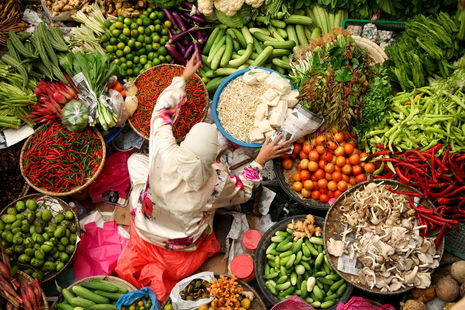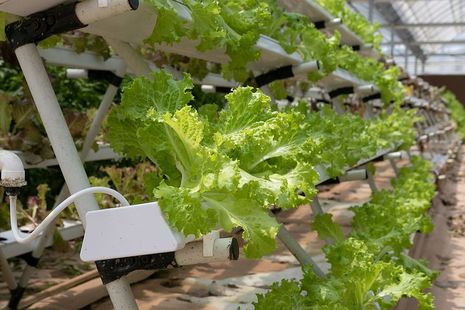The Future of Food
Grace Blackshaw explores the science and engineering research being conducted to feed the world in a growing climate crisis exacerbated by a burgeoning population.

Providing the world’s population with adequate, healthy, sustainable food is a complex undertaking - one which we are currently failing. Everyday, 821 million people go hungry and one third of the world’s population suffers from some form of malnutrition. By 2050, the population is expected to have reached 9.7 billion. The question is: what will we eat?
Before we turn to answers, there are further challenges to consider. The global agricultural industry has dire environmental impacts. It contributes to land degradation, deforestation, biodiversity loss, depletion of freshwater supplies, pollution and the climate crisis. In fact, agriculture is thought to account for 24% of all greenhouse gas emissions. This is not a one-sided relationship either: the climate crisis also poses a threat to the industry and is predicted to seriously exacerbate food shortages.
“Roughly one-third of the food produced for human consumption is lost or wasted globally.”
The most obvious solution is simply to increase the volume of food we are producing. Estimates of how much production would need to increase by vary. Research suggests that an increase of around 70% will be required.
In the 1960s, the Green Revolution saw a dramatic increase in the production of grains but it came with grave environmental costs. Future initiatives to intensify agricultural practises must learn from the past and recognise that the wellbeing of people and planet are crucially intertwined.
One such initiative comes in the form of vertical farms. A recent article in Nature suggests that climate-controlled farms - from traditional greenhouses to indoor LED-lit vertical farms - could improve food security, particularly for urban populations.

In vertical farms, soil is replaced by synthetic porous materials or crops are suspended in air and sprayed with a mist of water and nutrients. ‘Farmers’ can carefully control the temperature, the humidity, use LED lighting, automated nutrient dosing and CO2 enrichment. These farms have substantially higher yields per unit area than field farms, consume orders of magnitude less water, reduce the need for pesticides and shorten supply chains.
Other research suggests significant progress could be made by reducing food waste. Roughly one-third of the food produced for human consumption is lost or wasted globally. In developing countries, this primarily occurs between farmers and markets, due to unreliable transport and storage. By contrast, in developed countries, waste occurs mainly in homes, supermarkets and restaurants.
Solutions vary by context. In developing countries, the focus must be improving harvesting and storage techniques. In developed countries, such as the UK, the emphasis is on consumer actions. We need to be conscious of how much food we buy, keep on top of best-before dates, reuse leftovers and generally do our utmost to avoid the gut-wrenching feeling of emptying a Tupperware of leftovers straight into the bin.
These changes, from the industrial to the everyday, are all very well, but arguably it is most important to recognise that different food groups vary dramatically in their environmental impact. Feeding the world in 2050 will require significant dietary change. Despite only making up 15% of calories consumed, animal products are responsible for 75% of total agricultural emissions and 80% of land use.
Last year, the British medical journal the Lancet published the results of their commission on ‘healthy diets from sustainable food systems’, an interdisciplinary collaboration by 37 scientists.The recommendations were clear: ’a diet rich in plant-based foods and with fewer animal source foods confers both improved health and environmental benefits’. Regarding health benefits, they conclude that adopting a more plant-based diet could prevent approximately 11 million deaths each year.
This report is by no means the first to stress the dire environmental impacts of animal agriculture. A report from academics at the University of Oxford, analysed data from 38,700 farms and found that the impacts of animal products exceeded the impacts of substitute plant-based proteins across greenhouse gas emissions, eutrophication, acidification, and land use.
“Insects could be another important source of protein”
It is perhaps less obvious how choosing the veggie option over the beef could help alleviate global hunger, but the evidence is clear. Animal products are a massively inefficient use of calories. For every 100 calories of grain we feed animals, we get only 40 calories of milk, 22 of eggs, 12 of chicken, 10 of pork, or 3 of beef.
According to the Lancet commission, we need to more than halve our global consumption of red meat. Crucially, this should primarily be achieved by the dramatic reduction in excessive consumption in wealthier countries. In the UK, we need to eat 80% less red meat. To ease the transition, scientists and companies across the world are working to make meat substitutes as realistic as possible.
Launched in 2016, the Impossible Burger tastes like beef, smells like beef, bleeds, and is made entirely from plants. The secret: a compound called haem, found in animal blood and muscle.. Haem is very similar to leghemoglobin in soy. At Impossible Foods, they insert the genes for leghemoglobin into yeast, encourage the yeast to grow and then harvest the haem. According to their website, the Impossible Burger uses 95% less land, 74% less water, and 87% less greenhouse gas emissions than an equivalent beef burger.

Recently, a team of Cambridge researchers have taken the technology further. Most commercial companies rely on ‘muscle precursor cells’ which have a limited lifespan and need replenishing regularly. In contrast, the team led by Dr Mark Kotter aims to extract umbilical cord blood after a calf has been born and ‘reprogram’ it back into an ‘induced pluripotent stem cell’.
Away from the challenges of reality TV shows, insects could be another important source of protein. Last month, the Guardian reported that edible insects, such as mealworms, locusts and crickets, were set to be approved by the EU. For the more squeamish, this doesn’t necessarily entail locust kebabs – it could simply be protein bars or flour made from powdered crickets.
When making environmentally informed decisions, it can be hard to know what’s important. Focusing on food, the Lancet report is clear. Changes in how we produce and transport food could reduce agricultural greenhouse gas emissions in 2050 by 10%, halving food waste could achieve a 5% reduction, but changing to more plant-based diets could reduce emissions by up to 80%.
To feed the world in 2050, scientists, industries and governments will need to consider both people and planet. But when it comes to individuals, the scientific consensus is clear: we simply need to eat less meat.
 Comment / The (Dys)functions of student politics at Cambridge19 January 2026
Comment / The (Dys)functions of student politics at Cambridge19 January 2026 News / Local business in trademark battle with Uni over use of ‘Cambridge’17 January 2026
News / Local business in trademark battle with Uni over use of ‘Cambridge’17 January 2026 Features / Exploring Cambridge’s past, present, and future18 January 2026
Features / Exploring Cambridge’s past, present, and future18 January 2026 News / Your Party protesters rally against US action in Venezuela19 January 2026
News / Your Party protesters rally against US action in Venezuela19 January 2026 Lifestyle / Seoul food19 January 2026
Lifestyle / Seoul food19 January 2026







